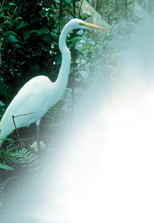
3.1 What Is Ecology?
 What is ecology?
What is ecology? What are biotic and abiotic factors?
What are biotic and abiotic factors? What methods are used in ecological studies?
What methods are used in ecological studies?
biosphere • species • population • community • ecology • ecosystem • biome • biotic factor • abiotic factor
Venn Diagram Make a Venn diagram that shows how the environment consists of biotic factors, abiotic factors, and some components that are truly a mixture of both. Use examples from the lesson.
THINK ABOUT IT Lewis Thomas, a twentieth-century science writer, was sufficiently inspired by astronauts' photographs of Earth to write: “Viewed from the distance of the moon, the astonishing thing about the earth… is that it is alive.” Sounds good. But what does it mean? Was Thomas reacting to how green Earth is? Was he talking about how you can see moving clouds from space? How is Earth, in a scientific sense, a “living planet”? And how do we study it?
Studying Our Living Planet
 What is ecology?
What is ecology?
When biologists want to talk about life on a global scale, they use the term biosphere. The biosphere consists of all life on Earth and all parts of the Earth in which life exists, including land, water, and the atmosphere. The biosphere contains every organism, from bacteria living underground to giant trees in rain forests, whales in polar seas, mold spores drifting through the air—and, of course, humans. The biosphere extends from about 8 kilometers above Earth's surface to as far as 11 kilometers below the surface of the ocean.

FIGURE 3–1 Levels of Organization The kinds of questions that ecologists may ask about the living environment can vary, depending on the level at which the ecologist works.
Interpret Visuals What is the difference between a population and a community?

Table of Contents
- Formulas and Equations
- Applying Formulas and Equations
- Mean, Median, and Mode
- Estimation
- Using Measurements in Calculations
- Effects of Measurement Errors
- Accuracy
- Precision
- Comparing Accuracy and Precision
- Significant Figures
- Calculating With Significant Figures
- Scientific Notation
- Calculating With Scientific Notation
- Dimensional Analysis
- Applying Dimensional Analysis




